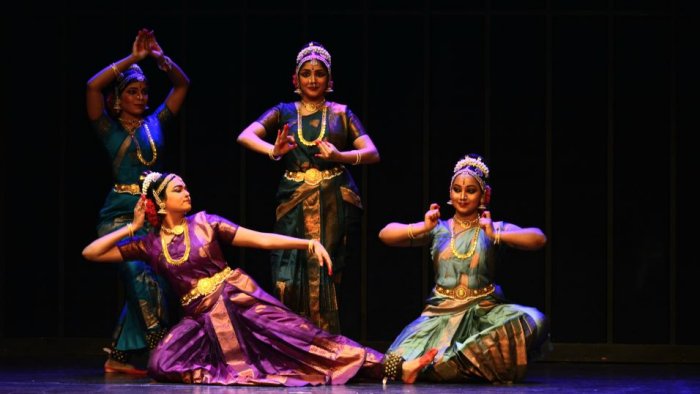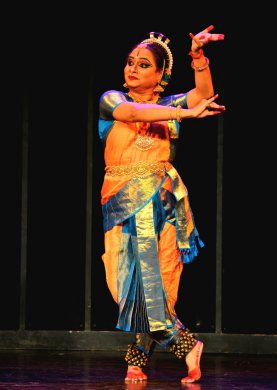
|   |

|   |
Sailaja's 'Divya Prabhavam': A portal to Krishna Consciousness - A.M. Hari Shankar e-mail: hshankar252@gmail.com Photos: Vaibhav Aggarwal June 24, 2023 The southeast coastal stretch of Andhra Pradesh-Telangana region once had a vast dimension of art forms ranging from classical to folk to tribal. Even in the classical genre, it has Kuchipudi, Vilasini Natyam, Andhra Natyam. Kuchipudi has a long legacy in Delhi and the art has become synonymous with the two legendary couple dancers, Raja-Radha Reddy and Dr. Jayarama Rao-Vanashree Rao here.  Recently, a Kuchipudi performance by Chennai based senior exponent Sailaja and her disciples of their new production 'Divya Prabhavam' - the divine influence, premiered at India Habitat Centre, New Delhi, was delightful not only for the merit of the dancer's superlative choreography and exposition, but also the expertise of uniqueness of the dancing skills that she has made her disciples to imbibe. The production basically had six choreographies, both solo and group on Krishna Bhakti theme. Commenced with a composition by Maharaja Swati Thirunal set in Arabhi and adi talam gave a spellbinding opening. Arabhi, an auspicious raga that emanates Veera (valour) rasa is always a clean sweep to start as it is known to create a bhakti emotive. "Sri Ramana vibho.... Naaga bhogashaya", the composer says, 'Oh! Beloved of Sridevi (Lakshmi), my obeisance to you who is always engrossed in protecting the ones who take refuge in you, the one who reclines on the serpent, has removed the fear of Kaliya in the cowherds.' The initial group performance by senior disciples had very intricate footwork that are distinct to the style of Sailaja. The famed composition of Thirunal "Gopalaka pahimam anisham" came next as a solo performance. This bhakti composition had praising of the Lord as the one worshipped by all deities and, "You are the one who bestowed your friend Sudama with boundless wealth and prosperity, Oh! Gopalaka, I submit myself at your feet, protect me forever." The episode of "sadhukati tamradashana saroshabhita matru vikasita bhudhahara jalanidhi mukha bahuvidha bhuvana jalalalita mukhambuja", enacting Krishna astonishing Yashoda by showing the entire universe inside his graceful lotus like mouth, showcased the dancer's prowess, who is acclaimed for her vivid expressions and pristine footwork, and got much applause in between the performance itself. This piece was in Revagupthi and misra chapu talam. Neeradasama Neelakrishna by Oothukadu Venkata Subbaiyer was the central piece of the evening where the Guru and her disciples danced to perfect sync and coordination. Subbaiyer says "Oh Lord Krishna who is as dark as the water bearing clouds, the one praised by Nigama (Vedas) and Agamas (Scriptures), protect me from the tensions of this mundane world. The one wearing fish shaped earrings, whose palm is resplendent due to small bangles around his wrist; you attract minds of common people and sages alike." This particular piece was an amalgamation of literature (sahitya), jathis, swaras, all exhibiting the essence and grammar of the dance style. Set in Jayanthasri ragam and tisra nadai adi talam, this comparatively high tempo piece was a delightful experience for the rasikas.  This was followed by the most awaited Tarangam by Sailaja's disciples. "Jaya Jaya Shrinivasa" set in Ragamalika and adi talam, a composition of Narayana Theertha from his illustrious work 'Srikrishna Leela Tharangini' and music inputs by S Rajeshwari. "Sundaracharan-a-aravinda maninoopura" was used for Tarangam, a unique segment of dancing specific to Kuchipudi repertoire where the dancer performs rhythmic patterns (usually jathis) on the rim of a brass plate and often balancing a small brass pot with or without water on their head (only brass plate was used here). The effortlessness in performing Tarangam is a substantiation of their training and practice. The very act of Tarangam has various aspects related to dance and mind-body-soul connection theory where the dancer's alertness (concentration) along with the years-long dedicated hard work on psycho-somatic level (physical-mental), only can contribute to the synergizing of the rhythmic patterns into the footwork, at the same time balancing one's body on the plate carrying pot over their head. It is a herculean task, but the success of which can be upshot as a cry of bravo in amazement, as happened after this performance, from the audience unfamiliar to these marvels of Kuchipudi. The solo ashtapadi from Prathama sarga, fourth padam of Jayadeva's Geeta Govinda, "Chandana charchitha" by Sailaja, set in Sumanesa Ranjani ragam, adi talam stood unique for her brilliance in delineating the emotive aspects of the composition. Krishna's bluish body is adorned with vanamala, smeared with sandal paste and he is wearing yellow silk robe. His earrings are dangling while he is playing the sport of love with Vrindavan gopikas. The subtle expressions of Sailaja conveyed the essence of Rasaleela. The portrayal in these lines, "Slishyati kaamapi chumbati kaamapi raamapi ramayati kaamapi...vaamaam" where the poet says that Krishna is embracing a gopika, while one kissing, another feeling delighted being with him, and him showering them with his attractive smile, was done in a composed way without overdoing it, owes great appreciation. Sailaja's team concluded with a high-powered item, Brahmam Okate, a composition in Telugu by the saint composer Tallapaka Annamacharya set in Bouli raagam, adi talam. Here, the composer vouches One-God theory and says for God everyone is equal, whether it is rich or poor, Brahmin or Chandala, king or a servant, the sense of pleasure, the length of day-night. For all good and bad, Lord Venkateshwara of Tirupati is our only saviour. In between each charanam, "Thandannana na ne," gave a strong rhythmic punch all through the lyrics and also added a regional fervor of Telugu folk song traditions.  Sailaja Sailaja performed with pre-recorded music. Even though having accompanying artists while traveling across cities is an uphill task, the charisma the performance might have got with live orchestration cannot be ignored. The comparatively thin audience turned out to be ardent art rasikas, except for a few youngsters' unrestrained cheering and levity. In total, the programme was well-organised with a precise narration regarding the context and interpretation of the forthcoming items by Sailaja herself. The students of Saila Sudha Academy, Chennai, who accompanied Sailaja were Aarthi Vasudevan, Sreshtaa Harish, Vidhya S, Rashmi Chowaloor and Abhirami Devi, all apparently to be the next foremost names of Sailaja's repertory.  A.M. Hari Shankar, an art enthusiast, percussionist and a connoisseur of Indian classical Arts, is a Biologist-Educationist by profession, based in Delhi. Recipient of the Ministry of Culture Scholarship, his areas of interest include Life Science, Indian Arts and Spirituality. Some of his articles have been published in leading journals and newspapers. |